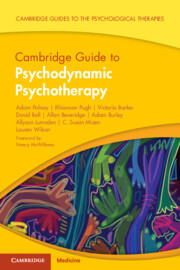Book contents
- Cambridge Guide to Psychodynamic Psychotherapy
- Cambridge Guides to the Psychological Therapies
- Reviews
- Cambridge Guide to Psychodynamic Psychotherapy
- Copyright page
- Dedication
- Contents
- Foreword
- Preface
- A Note from the Series Editor
- Acknowledgements
- Part 1: An Overview of the Model
- Part 2: The Model of Psychodynamic Psychotherapy into Practice
- Part 3: Application for Mental Health Presentations
- Applications of Psychodynamic Psychotherapy with Accompanying Case Study Description for Each Presentation
- Chapter 11 Psychodynamic Approaches to Anxiety
- Chapter 12 The Psychodynamics of Depressing/Depressed States
- Chapter 13 Dynamics of Borderline States of Mind
- Chapter 14 Narcissistic Difficulties, a Trans-Diagnostic Presentation Requiring a System-Wide Approach
- Part 4: Application of Psychodynamic Psychotherapy in Different Populations and in Different Settings
- Glossary of Terms
- Index
- References
Chapter 14 - Narcissistic Difficulties, a Trans-Diagnostic Presentation Requiring a System-Wide Approach
from Applications of Psychodynamic Psychotherapy with Accompanying Case Study Description for Each Presentation
Published online by Cambridge University Press: 25 August 2023
- Cambridge Guide to Psychodynamic Psychotherapy
- Cambridge Guides to the Psychological Therapies
- Reviews
- Cambridge Guide to Psychodynamic Psychotherapy
- Copyright page
- Dedication
- Contents
- Foreword
- Preface
- A Note from the Series Editor
- Acknowledgements
- Part 1: An Overview of the Model
- Part 2: The Model of Psychodynamic Psychotherapy into Practice
- Part 3: Application for Mental Health Presentations
- Applications of Psychodynamic Psychotherapy with Accompanying Case Study Description for Each Presentation
- Chapter 11 Psychodynamic Approaches to Anxiety
- Chapter 12 The Psychodynamics of Depressing/Depressed States
- Chapter 13 Dynamics of Borderline States of Mind
- Chapter 14 Narcissistic Difficulties, a Trans-Diagnostic Presentation Requiring a System-Wide Approach
- Part 4: Application of Psychodynamic Psychotherapy in Different Populations and in Different Settings
- Glossary of Terms
- Index
- References
Summary
This chapter describes two types of projective identification, acquisitive and attributive, which dominate relating towards self and other in the most severe and complex interpersonal difficulties commonly diagnosed as ‘personality disorder’. These difficulties are defined in psychoanalytic terms as narcissistic. These two forms of projective identification result in a distorted psychosomatic sense of what belongs to whom in the internal world, relating to others and relating to the body. This leads to complex somatic symptoms such as eating disorders and psychosomatic presentations. They also drive the pattern of service use: acquisitive projective identification leading to a pattern of medical or mental health hospitalisation and a requirement for 24-hour care; and attributive projective identification resulting in disengagement and denial of need. The chapter describes the patterns of interpersonal engagement and conflict commonly found in those with the most severe and complex problems in inpatient settings. Furthermore, a psychodynamic formulation is provided to aid teams in understanding these interpersonal dynamics, provide clarity in planning long-erm care, and to identify adaptations of technique required in psychotherapeutic work.
Keywords
- Type
- Chapter
- Information
- Cambridge Guide to Psychodynamic Psychotherapy , pp. 211 - 228Publisher: Cambridge University PressPrint publication year: 2023



